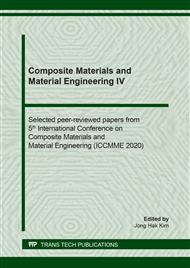p.81
p.87
p.95
p.102
p.108
p.114
p.120
p.129
p.135
Effect of Surface Modification on Multi-Walled Carbon Nanotubes and their Reinforced Nylon Composites
Abstract:
In this study, a series of nanocomposites were prepared by melt-blending method using Nylon (Nylon12, PA12) and multi-walled carbon nanotubes (MWCNTs) with various contents such as 0.0 wt.%, 0.5 wt.%, 1.0 wt.%, 3.0 wt.%. In order to improve the dispersion of MWCNTs in composites, the MWCNTs were first acid treated by the HNO3 solution to functionalize the carboxylic groups on the surface. Subsequently, this acid treated MWCNTs were reacted with Polyetheramine (Jeffamine® M2070) and Polyethylenimine under mild conditions, respectively, to obtain the chemically modified MWCNTs (M-M2070 and M-PEI). The amide groups formed on these chemically modified MWCNTs will enhance the compatibility of MWCNTs and Nylon. The effects of different modification methods on the thermal properties, mechanical properties and electrical resistance of these Nylon12/MWCNTs composites were investigated. The results showed that M-M2070 and M-PEI dispersed in Nylon12 homogeneously, and can improve the mechanical and thermal properties of the composite materials effectively. The DMA analysis revealed that the storage moduli of nanocomposites were increased with increasing MWCNTs content. Among all, the nanocomposites containing 3wt% of M-M2070 and M-PEI were shown increased storage moduli 48.2% and 29.8%, respectively. TGA analysis showed that pyrolysis temperature of neat Nylon12 was 412.7 °C, and was increased about 43 °C by addition of M-M2070 and 36.7 °C by addition of M-PEI. Moreover, the surface resistance of neat Nylon12 was 1.68×1014 ohm/sq, and was decreased to 1.33×105 and 4.34×106 ohm/sq by addition of 3wt% M-M2070 and M-PEI, respectively. The resistance values of these nanocomposites have achieved the level of static dissipation, and can prevent the harm of static electricity.
Info:
Periodical:
Pages:
108-113
Citation:
Online since:
June 2020
Price:
Сopyright:
© 2020 Trans Tech Publications Ltd. All Rights Reserved
Share:
Citation:


